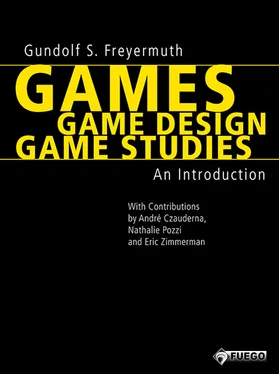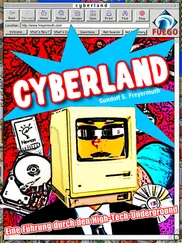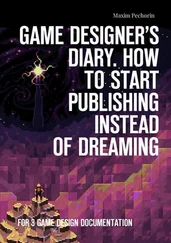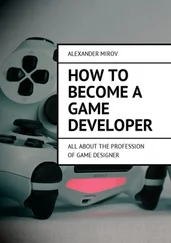Gundolf S. Freyermuth
Games, Game Design, Game Studies
An Introduction
– English edition –
FUEGO
About this Book
How did games rise to become the central audiovisual form of expression and storytelling in digital culture? How did the practices of their artistic production come into being? How did the academic analysis of the new medium's social effects and cultural meaning develop?
Addressing these fundamental questions and aspects of digital game culture in a holistic way for the first time, Gundolf S. Freyermuth's introduction outlines the media-historical development phases of analog and digital games, the history and artistic practices of game design, as well as the history, academic approaches, and most important research topics of game studies.
The Author
Gundolf S. Freyermuth (PhD) is Professor of Media and Game Studies and a founding director of the Cologne Game Lab at TH Köln–University of Applied Sciences in Cologne, Germany. He also teaches Comparative Media Studies at the ifs international film school Cologne. His research interests include video games, audiovisuality, transmediality, and network culture.
Homepage: www.freyermuth.com
Imprint
© 2015 by Gundolf S. Freyermuth
Für die vorliegende ePub-Edition
© 2016 FUEGO
www.fuego.deeISBN 978-3-86287-177-3
All rights reserved. Without limiting the rights under copyright reserved above, no part of this publication may be reproduced, stored in or introduced into a retrieval system, or transmitted, in any form, or by any means (electronic, mechanical, photocopying, recording, or otherwise) without the prior written permission of both the copyright owner and the above publisher of this book.
A print as well as a pdf edition of this book are available from transcript (Bielefeld, http://www.transcript-verlag.de/978-3-8376-2983-5/games-game-design-game-studies) and Columbia University Press (New York, http://cup.columbia.edu/book/games-game-design-game-studies/9783837629835)
Contents
PROLOG
PLAYING, MAKING, THINKING GAMES |
Playing—Games | Making Games—Game Design | Thinking Games—Game Studies | Acknowledgments
I GAMES
INTRODUCTION |
1 WHAT IS A GAME? SYSTEMATIC AND HISTORICAL APPROACHES |
Attempts at Systematic Definitions | Failure of Systematic Definitions | Historical Definition: The Alterity of Digital Games
2 GAMES IN THE MODERN ERA. A SHORT MEDIA HISTORY |
Games | Primary, Secondary, and Tertiary Mediality | Case Study: Soccer—A Game’s Journey Through Medialities | Quaternary Mediality: From Spectator to Player
3 PROCEDURAL TURN (SINCE THE 1950S) |
Quadruplicate Origin of Digital Games | Digital Technology | Artificial Intelligence | Flight Simulation | Virtualization of Analog Games | Playful Use of Digital Technology | Procedurality
4 HYPEREPIC TURN (SINCE THE 1970S) |
Game Economics | From Mainframe and Arcade Games to Console and PC Games | The Innovative Genre of Text-Adventures | The Evolution of Audiovisual Storytelling | The Hyperepic
5 HYPERREALISTIC TURN (SINCE THE 1990S) |
Digital Technology| From the Model of the Novel to the Model of the Film | Hyperrealism | Authenticity and Operativity | The Innovative Genre of the First-Person Shooter
6 THE DOUBLE ALTERITY OF DIGITAL GAMES |
The Evolution of Games into an Audiovisual Medium | Digital Games vs. Analog Games and Linear Audiovisions | The Defining Medium of Digital Culture
7 A LOOK AHEAD: HYPERIMMERSIVE TURN? |
The Evolution of Digital Games | Lifelike Agency in Games | Utopia Holodeck | Gamelike Agency in Real Life | Potential for Hyperimmersive Turn
INTERMEZZO: GAME // FILM
INTRODUCTION |
1 GAME AND FILM |
Competition | Collaboration | Convergence
2 AUDIOVISUAL RIVALRIES |
Media History | Media Theory
3 MODES OF AUDIOVISUAL STORYTELLING |
Storytelling in Space and Time | Pre-Industrial Audiovisions: Theater | Industrial Audiovisions: Film and Television | Digital Audiovisions: Games | Complementarity | Summary: The Four Cs
II GAME DESIGN
INTRODUCTION |
1 ANALOG DESIGN |
The Evolution of Industrial Design Practices | The Evolution of Industrial Design Thinking
2 DIGITAL DESIGN |
The Digitalization of Design Practice | The Digitalization of Design Thinking
3 A SHORT HISTORY OF GAME DESIGN |
The First 40 Years | Present and Future
4 AREAS OF GAME DESIGN |
The Role of the Game Designer | Triad, Tetrad, and the Function of Narration
5 PRACTICES OF GAME DESIGN |
The Process of Game Development | The Principle of Worldbuilding | Authorship in Game Design | Don't Follow These Rules! A Primer for Playtesting by Nathalie Pozzi and Eric Zimmerman
III GAME STUDIES
INTRODUCTION |
1 THEORIES OF ANALOG GAMES VS. THEORIES OF DIGITAL GAMES |
Pre-Industrial Theories of Playing and Games | Industrial Theories of Playing and Games
2 THE SCHISMS OF GAME STUDIES |
Sedimentative Approaches: Game Design Theories | Exaptative Approaches 1: Theories from Social Sciences | Exaptative Approaches 2: Theories from the Humanities
3 DESIDERATUM: OVERCOMING THE SCHISMS |
Longing for Synthesis | Adaptative Approaches
4 PERSPECTIVES OF RESEARCH 1: DIGITAL GAMES |
Mechanics | Story | Aesthetics | Technology | Transmedia
5 PERSPECTIVES OF RESEARCH 2: SERIOUS GAMES |
Mechanics, Story, Aesthetics, Technology, Transmedia | Gamification | Opposition to Industrialism
EPILOG
ACADEMIZATION AND AESTHETIC PRODUCTION |
The Cultural Rise of Games | Game Studies and Digital Game Design Education in Germany | International Higher Game Design Education: Six Examples from Five Countries by André Czauderna | Structure of an Undergraduate Program for Game Design | Consequences of Academization
SOURCES |
Prolog
Playing, Making, Thinking Games
In the early 21st century we are now experiencing—as witnesses and as protagonists—the aesthetic development and cultural rise of a new audiovisual form of expression and narration. Like earlier forms of defining audiovisual media, such as theater, film, and television, digital games are shaping our self-perception as well as our perception of the world around us. Parallel to this development, two new practices and fields of research are emerging:
For one, new practices in the field of software development—part handicraft, part art—are coming about, organized under the headings “Media Design” and “Game Design.” Just as games differentiate themselves from movies through dramatic composition and means of representation—by tending towards nonlinearity and iterative experiences—, so does game design differentiate itself from the traditional practices of analog film production through iterative and less-linear tendencies.
Second, a new academic discipline is forming: the analytical and critical interpretation of digital games. Just as we speak of literary studies, film studies, or design studies, so may we speak of Game Studies.
Consequently, the goal of this book is to offer a part-historical, part-theoretical introduction to address three aspects of digital games: 1) the origin and history of the new medium digital games, 2) the innovative processes of their production, and 3) the emerging discipline of their academic investigation. The following questions lie at the center of this study:
How did digital games come to be and how did they rise to become the central audiovisual form of expression and storytelling in digital culture?
How did the procedures of their technical-artistic production develop and what are the current practices of game design?
How did the academic analysis of the social effects and cultural meaning of digital games form?
Читать дальше











